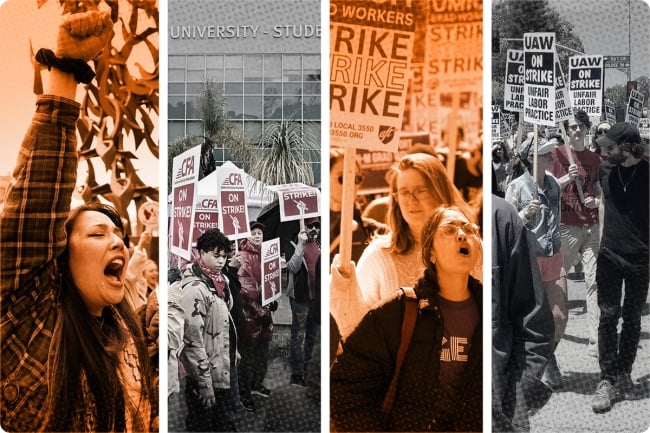You have /5 articles left.
Sign up for a free account or log in.

Academic worker unionization has surged since 2012, according to a new report.
Higher education unionization has been surging. Story after story of successful union drives has suggested this. But a new report, which collected data on more than 95 percent of the collective bargaining relationships between academic workers and their institutions, finally provides national figures for the phenomenon.
The biggest boom was among graduate student workers. In 2012, the first year of the study period, they had about 64,400 unionized employees among their ranks. But, by early 2024, that number surged to 150,100. That's a 133 percent increase, and 38 percent of grad workers are now unionized.
The number of unionized faculty members rose more slowly, from roughly 374,000 in 2012 to 402,000 in January, when the study ended—around a 7 percent increase. That means more than one in four faculty members are unionized, according to the report from the National Center for the Study of Collective Bargaining in Higher Education and the Professions at Hunter College, part of the City University of New York.
These figures are from the center’s new Directory of Bargaining Agents and Contracts in Institutions of Higher Education, a 114-page report released today that includes hyperlinks to over 800 collective bargaining agreements.
Joe Berry, a labor historian, said, “The trend has been definitely for people to organize.” He said, “There’s a number of reasons for that, but I would say the No. 1 reason has been the progressive casualization of the faculty—the turning of the majority of the faculty into contingent workers.”
Berry, a longtime contingent faculty member himself, said the “campus labor movement has been one of the healthiest parts of the labor movement, even in its darkest days over the past 20, 30 years.”
The National Center’s data does show that higher education’s unionization trends are diverging from what’s happening off of campuses. While the share of faculty members and grad workers who are unionized has risen, the U.S. Bureau of Labor Statistics says the proportion of American workers overall who are unionized dropped from around 13 percent in 2012 to just 11 percent in 2023.
The report also shows changes in who’s seeing the most unionization: The main action has moved to private, nonprofit colleges and universities.
A Private-Sector Push
In 2004, the National Labor Relations Board ruled against a graduate student union forming at Brown University, effectively preventing these workers from organizing at private colleges and universities. The ruling didn’t affect grad workers at public institutions, but whether those students could unionize or not was already left to the whims of state lawmakers, who set their states’ public sector collective bargaining laws.
But in 2016, the NLRB reversed course, ruling that Columbia University graduate student workers could unionize. That cleared the way for others at private universities to do the same. Some union organizers said they withdrew their petitions during the Trump presidency, but the organizing push at private universities surged forward after his successor named labor-friendly appointees to the NLRB and the pandemic abated. The report finds roughly 64,000 grad workers newly unionized between 2021 and 2023, nearly triple the number “during the prior eight years combined.”
Sixty percent of the increase in unionized grad workers since 2012 occurred at private colleges and universities, the report finds. And as the center notes, the unionization of grad workers at private institutions has sped along this year as well, beyond the January 2024 end point of the report.
As for faculty members, William A. Herbert, the National Center’s executive director, told Inside Higher Ed that unionization at private institutions started declining after a 1980 court decision. But then, he said, private institutions started relying more on instructors who weren’t on the tenure track—and who unionized.
Prior to 2012, faculty unionization grew much faster at community colleges and public four-year institutions than at private colleges and universities, the report says. Private institutions “saw periods of actual decline resulting from the Yeshiva decision,” the report says, referring to the 1980 U.S. Supreme Court decision NLRB v. Yeshiva University, which held that tenured and tenure-track faculty members at private universities don’t have the right to unionize.
But after 2012, faculty unionization at private, nonprofit institutions ramped up. In fact, the report said the number of union-represented faculty members at private colleges and universities grew by 56 percent since that year, compared to just 4 percent among public institutions. And since that year, most new faculty bargaining units have been at private institutions, “nearly doubling the total number of private sector units.”
Non-tenure-track faculty members are driving this trend. They face lower pay and less job security. Jacob Apkarian, who worked on the report and is an associate sociology professor at the City University of New York’s York College, said they’re “being squeezed more and more.”
Adrianna Kezar, a professor of higher education at the University of Southern California, said the report, which she didn’t write, “finally captures what I think we’ve heard anecdotally from many people.” What she’s heard is that “there is increasing disgruntlement among faculty and an interest in creating better work environments.”
Herbert cited another factor: Around 2012 and 2013, national unions began supporting faculty who had already been trying to unionize on their own. For decades, there were around 70 to 85 bargaining units of faculty members at private, nonprofit institutions, Apkarian said. “It was almost the same for 30 years.” Now, he said, there are 150.
Apkarian said the Service Employees International Union, in particular, seemed to recognize that faculty who weren’t on a tenure track represented a big, untapped niche “and really went hard” at organizing them. Clearly, though, SEIU wasn’t alone.




